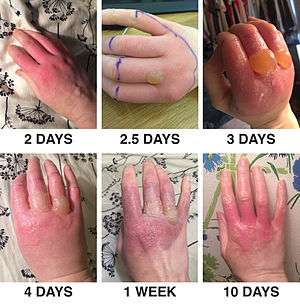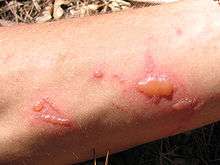Phytophotodermatitis
| Phytophotodermatitis | |
|---|---|
 | |
| Phytophotodermatitis caused by lime | |
| Classification and external resources | |
| Specialty | dermatology |
| ICD-10 | L56.2 |
| DiseasesDB | 31395 |
Phytophotodermatitis, also known as "lime disease" (not to be confused with Lyme disease),[1] "Berloque dermatitis",[2] or "Margarita photodermatitis"[3][4] is a chemical reaction which makes skin hypersensitive to ultraviolet light. It is frequently mistaken for hereditary conditions such as atopic dermatitis or chemical burns, but it is caused by contact with the photosensitizing compounds found naturally in some plants and vegetables like parsnips, citrus fruits and more. Symptoms include burning, itching, stinging and large blisters that slowly accumulate over time.[5]
Symptoms
The symptoms are equivalent to photodermatitis, but vary in severity. The skin condition is a cutaneous phototoxic inflammatory eruption resulting from contact with light-sensitizing botanical substances—particularly from the plant families Umbelliferae, Rutaceae, Moraceae, and Leguminosae—and ultraviolet light, typically from sun exposure. Phytophotodermatitis usually results in hyperpigmentation of the skin that often appears like a bruise. This may be accompanied by blisters or burning. The reaction typically begins within 24 hours of exposure and peaks at 48–72 hours after the exposure.[6]


Phytophotodermatitis can affect people of any age. Because of the bruise-like appearance that is usually in the shape of handprints or fingerprints, it can be mistaken in children for child abuse.[7]
Common causes
- Parsnip, parsley, celery, common hogweed, giant hogweed[8][9][10]
- Carrot[11] and wild carrot[6]
- Notobubon galbanum (previously known by the synonym Peucedanum galbanum),[12] a South African plant also known as "blister bush", "hog's fennel", or locally in Afrikaans as bergseldery (i.e. "mountain celery")[13]
- Lemon, lime, bergamot orange[1][8][14]
- Common rue (Ruta graveolens) and other plants in the genus Ruta[15][16][17][18]
- Sclerotinia sclerotiorum, which can infect celery[19]
- Common fig, its latex contains various furocoumarin isomers such as 8-methoxypsoralen, which induce allergic photodermatitis[8][20][21]
Treatment
Phytophotodermatitis can be prevented by staying indoors after handling the above substances. However, the primary triggering mechanism is UV-A radiation (320-380 nm) which windows are not guaranteed to filter out.
Many different topical and oral medications can be used to treat the inflammatory reaction of phytophotodermatitis. A dermatologist may also prescribe a bleaching cream to help treat the hyperpigmentation and return the skin pigmentation back to normal. If they do not receive treatment, the affected sites may develop permanent hyperpigmentation or hypopigmentation.[6]
See also
- List of cutaneous conditions
- Psoralen
- Photosensitivity in humans
- Stinging plant, plants with hairs that inject poisons
References
| Wikimedia Commons has media related to Phytophotodermatitis. |
- 1 2 Weber, Ian C; Davis, Charles P; Greeson, David M (1999). "Phytophotodermatitis: The other 'lime' disease". The Journal of Emergency Medicine. 17 (2): 235–7. doi:10.1016/S0736-4679(98)00159-0. PMID 10195477.
- ↑ James, William Daniel; Berger, Timothy G.; Elston, Dirk M., eds. (2006). Andrews' Diseases of the Skin: clinical Dermatology. Saunders Elsevier. p. 32. ISBN 978-0-7216-2921-6.
- ↑ Riahi, Ryan R.; Cohen, Philip R.; Robinson, Floyd W.; Gray, James M. (June 2009). "What Caused The Rash On This Man's Wrist And Hand?". The Dermatologist. 11 (6).
- ↑ Abramowitz, Alan I.; Resnik, Kenneth S.; Cohen, Kenneth R. (1993). "Margarita Photodermatitis". New England Journal of Medicine. 328 (12): 891. doi:10.1056/NEJM199303253281220. PMID 8441448.
- ↑ Solis, R. R.; Dotson, DA; Trizna, Z (2000). "Phytophotodermatitis: A Sometimes Difficult Diagnosis". Archives of Family Medicine. 9 (10): 1195–6. doi:10.1001/archfami.9.10.1195. PMID 11115230.
- 1 2 3 Phytophotodermatitis at eMedicine
- ↑ Barradell, R.; Addo, A.; McDonagh, A. J. G.; Cork, M. J.; Wales, J. K. H. (1993). "Phytophotodermatitis mimicking child abuse". European Journal of Pediatrics. 152 (4): 291–2. doi:10.1007/BF01956735. PMID 8482273.
- 1 2 3 Photocontact dermatitis. DermNet NZ
- ↑ Lutchman, L; Inyang, V; Hodgkinson, D (1999). "Phytophotodermatitis associated with parsnip picking". Emergency Medicine Journal. 16 (6): 453–4. doi:10.1136/emj.16.6.453. PMC 1343418
 . PMID 10572825.
. PMID 10572825. - ↑ Giant Hogweed phytophotodermatitis GPnotebook login required
- ↑ Klauder, Joseph V.; Klauder, JV (1956). "Sensitization Dermatitis to Carrots: Report of Cross-Sensitization Phenomenon and Remarks on Phytophotodermatitis". Archives of Dermatology. 74 (2): 149–58. doi:10.1001/archderm.1956.01550080035006. PMID 13353987.
- ↑ The Plant List (2013). Version 1.1. Published on the Internet; http://www.theplantlist.org/ (accessed 19th December 2015)
- ↑ Manning, John (2008). Field Guide to Fynbos. Cape Town: Struik Publishers. ISBN 9781770072657.
- ↑ Leung; Fong, Justine H. S. (April 1, 2003). "Alexander K. C".
- ↑ Arias-Santiago, S. A.; Fernández-Pugnaire, M. A.; Almazán-Fernández, F. M.; Serrano-Falcón, C.; Serrano-Ortega, S. (2009). "Phytophotodermatitis due to Ruta graveolens prescribed for fibromyalgia". Rheumatology. 48 (11): 1401. doi:10.1093/rheumatology/kep234. PMID 19671699.
- ↑ Furniss, Dominic; Adams, Titus (2007). "Herb of Grace: An Unusual Cause of Phytophotodermatitis Mimicking Burn Injury". Journal of Burn Care & Research. 28 (5): 767–9. doi:10.1097/BCR.0B013E318148CB82. PMID 17667834.
- ↑ Eickhorst, Kimberly; Deleo, Vincent; Csaposs, Joan (2007). "Rue the Herb: Ruta graveolens–Associated Phytophototoxicity". Dermatitis. 18 (1): 52–5. doi:10.2310/6620.2007.06033. PMID 17303046.
- ↑ Wessner, D.; Hofmann, H.; Ring, J. (1999). "Phytophotodermatitis due to Ruta graveolens applied as protection against evil spells". Contact Dermatitis. 41 (4): 232. doi:10.1111/j.1600-0536.1999.tb06145.x. PMID 10515113.
- ↑ Centers for Disease Control (CDC) (January 11, 1985). "Phytophotodermatitis among Grocery Workers - Ohio". Morbidity and Mortality Weekly Report. 34 (1): 11–3. PMID 3155560.
- ↑ Bonamonte D, Foti C, Lionetti N, Rigano L, Angelini G (June 2010). "Photoallergic contact dermatitis to 8-methoxypsoralen in Ficus carica". Contact Dermatitis. 62 (6): 343–8. doi:10.1111/j.1600-0536.2010.01713.x. PMID 20557340.
- ↑ allergy to latex, including fig latex http://www.medic8.com/healthguide/allergies/latex-allergies/symptoms-latex-allergy.html